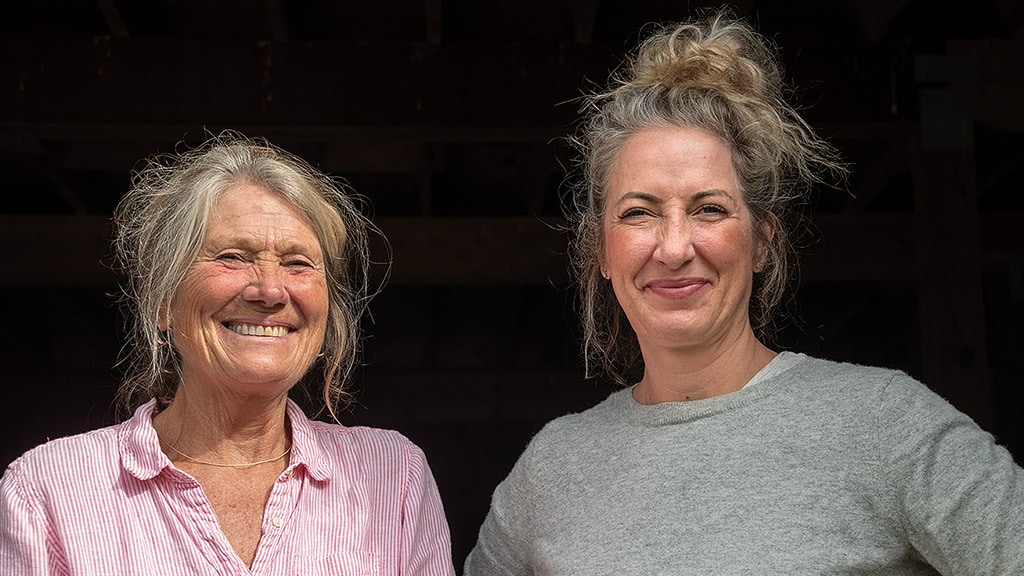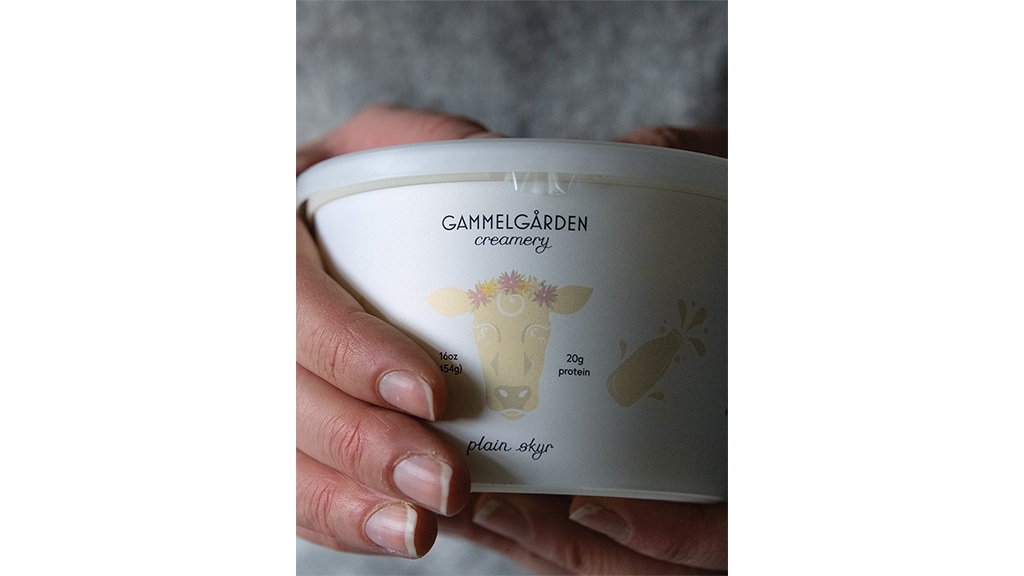
Stina Kutzer (left), her daughter Signe O'Neil, and Merci the cow share a moment in the hills of Pownal, Vermont. Merci is a descendant of Kutzer's first Jersey, Babette, the cornerstone of the family's skyr business.
Agriculture, Livestock/Poultry June 01, 2024
Babette's Sweet Legacy
New England meets Iceland in this family's handmade skyr.
by Steve Werblow
In 2004, Peter Kutzer gave his wife Stina a Jersey calf. Stina named her Babette and grazed her in emerald pastures ringed by hardwoods in the town of Pownal in the southwestern corner of Vermont—as close to cow heaven as Babette could get. When Babette bore twin heifer calves, Stina decided it was time to figure out how to put her tiny herd to work.
"That's right when the local food movement really took off, and there was a big CSA [community supported agriculture] right around the corner," she says.
Kutzer had made butter and cheese for her family as her kids were growing up. But butter turned out to be too labor-intensive and low-yielding to make money. Soft cheeses like Brie and Camembert required a lot of infrastructure for production and several weeks of aging. Kutzer experimented with yogurt cultures and was zeroing in on recipes she liked, but learned from the local milk inspector that yogurt would also have required stainless steel equipment and adherence to strict processing rules.
Enter skyr (pronounced "skeer"), a creamy, yogurt-like treat traditionally made in Iceland.
"Skyr is technically a soft cheese—for every 90-gallon batch, I put in half a teaspoon of vegetable rennet," says Kutzer.
That satisfied the milk inspector. Kutzer wasn't in the yogurt business—instead, she had become a cheesemaker.
There was a small hurdle. Kutzer wanted to honor her family's Swedish roots, and an Icelandic cheese seemed close...but not quite close enough.
"Because we're Swedish, we thought, 'maybe there's some kind of Swedish something we could call it,'" says Kutzer. "But as we investigated, we saw that what we were doing is exactly how they make skyr in Iceland. So we said, 'OK, we're going to call it skyr.'"
In 2010, Kutzer and her sister Marta Willett opened Gammelgården Creamery, which means "small, old farm" in Swedish.
Let it hang. Kutzer, her daughter Signe O'Neil, and their 6 employees make Gammelgården skyr 90 gallons at a time, 3 or 4 days a week. They pasteurize their milk in the evenings and hold it at about 100 degrees F (37.7° C). They add a blend of live, probiotic yogurt cultures carefully selected to yield the perfect level of mild tartness and creamy texture.
Finally, they hang the skyr in cheesecloth for 1.5 to 2 hours to drain off whey and allow the product to thicken.
Kutzer and O'Neil have expanded their skyr line to include a range of flavors. The experimentation started with 4 gallons of maple syrup that Kutzer's sister Carla shared early in the venture. Maple remains one of Gammelgården's top flavors, vying with wild Maine blueberry. There's also lemon hibiscus, cherry almond, strawberry, raspberry, pumpkin, and apple pie, each added to the skyr as jam from local producers.
Above. Kutzer and O'Neil oversee production, packaging, and product development (Kutzer's sister Marta does the books). Peter Kutzer has delivered skyr since 2010; soon he'll get help from a local distributor. O'Neil designed Gammelgården's packaging and website. The company's logo commemorates Babette and her twin calves.
Building markets. Gammelgården introduced skyr through countless tastings at three farmers' markets and through the local CSA's subscription. Grocery stores caught on, and Peter Kutzer got to work hauling skyr across southern Vermont and western Massachusetts.
Peter's delivery runs have provided vital feedback on flavors, packaging, and what's moving off the shelves, notes O'Neil.
The farm-fresh skyr also built a loyal (and hungry) following at Williams College, just up the road from Babette's pasture.
Supplying the college created high demand during the school year and a huge drop-off during summer break. Even as her herd peaked with 14 Jerseys, Kutzer started to fill the gap with milk from neighbors at Hooskip Dairy, hauling 10-gallon cans from the 60-head Holstein operation.
Like many businesses, Gammelgården pivoted when COVID shut down Williams College in 2020.
"That jumpstarted the whole shipping department," says O'Neil, who developed a beautiful online order system and packaging for direct-to-consumer sales.
Though they have occasionally shipped skyr to California and Florida, costs and logistics keep them focused primarily on the Northeast. That's home to many people who got a taste for their skyr on vacation in Vermont, and Williams College alumni eager to load up on their favorite flavors.
Look ahead. Babette lived until 2023, watching Gammelgården grow. Today, 3 of her descendants graze through their retirement on the Kutzers" 10 acres. Stina Kutzer no longer milks them, but she, O'Neil, and Gammelgården staff continue to share their luscious, hand-crafted taste of Vermont—and Iceland—with delighted customers near and far.
"It's probably the most gratifying thing I've ever done," says Kutzer. "It"s a job you see through from beginning to end, and it's very rewarding." ‡
Read More

AGRICULTURE, SUSTAINABILITY
Teaming up with Nature
Agroecology helps the desert bloom on this California homestead.

AGRICULTURE, LIVESTOCK/POULTRY
Reaching for the Stars
StarWalker Organic Farms shares regenerative story with beef and pork fans nationwide.



